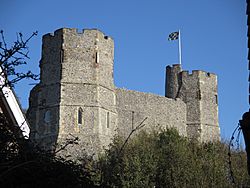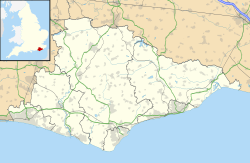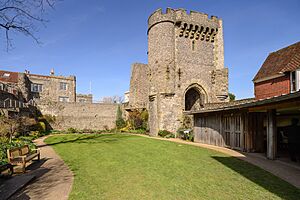Lewes Castle facts for kids
Quick facts for kids Lewes Castle |
|
|---|---|
| Lewes, East Sussex | |

Two towers of Lewes Castle, East Sussex, photographed from the west
|
|
|
Shown within East Sussex
|
|
| Coordinates | 50°52′22″N 0°00′27″E / 50.8729°N 0.0076°E |
| Type | Norman |
| Site information | |
| Open to the public |
Yes |
| Site history | |
| Built | late 11th century |
| Built by | William de Warenne, 1st Earl of Surrey |
| Materials | Stone |
| Official name: Lewes Castle | |
| Designated: | 28 August 1915 |
| Reference #: | 1013268 |
Lewes Castle is an old medieval castle in the town of Lewes, located in East Sussex, England. It was first called Bray Castle. The castle sits in a very important spot. It guards a gap in the South Downs hills, which was created by the River Ouse. The towns of Lewes and Cliffe are also in this gap.
The castle stands on a hill made by people, just north of the main street in Lewes. It is built using local limestone and flint stones.
Contents
History of Lewes Castle
Lewes Castle is a special type of castle called a motte and bailey. What makes it unusual is that it has two large mounds, or "mottes." The only other castle in England with two mottes is Lincoln Castle.
Building the Mottes
The first mound, known as Brack Mount, was finished soon after the Norman Conquest of England in 1066. The second mound, called the Keep, was completed in the late 11th century. Both of these mounds were built by William de Warenne, 1st Earl of Surrey.
At first, these mounds had wooden fences, called palisades, on top of them. But in the early 12th century, these wooden fences were replaced with strong stone walls, known as shell keeps. The area around the castle, called the bailey, also had a stone wall with towers for protection.
Castle in Battle
In 1264, soldiers left Lewes Castle to fight against Simon de Montfort. This important event was the Battle of Lewes.
Later Additions and Ownership
During the 13th century, towers were added to one of the stone shell keeps. A special gatehouse, called a barbican, was built in the 14th century. This barbican helped protect the castle entrance.
The last owner from the de Warenne family was John de Warenne, 7th Earl of Surrey. He passed away in 1347 and was buried at Lewes Priory. His title then went to his nephew, Richard FitzAlan, 10th Earl of Arundel.
Later, in 1850, the Sussex Archaeological Society started to rent the castle. In 1922, a person named Charles Thomas-Stanford bought the castle and gave it as a gift to the Sussex Archaeological Society. They still look after it today.
Wall Collapse Incident
On November 11, 2019, a part of the castle's outer wall, called a curtain wall, collapsed. A section about 10 meters by 10 meters fell onto a nearby house and garden. Emergency teams quickly searched the area. Luckily, no one was hurt.
The Sussex Archaeological Society explained that the collapsed wall was privately owned. It was one of the last parts of the original curtain wall that they did not own. They also said that the parts of the castle owned by the society are checked every year by experts. The castle was closed for a short time to make sure everyone was safe. News reports at the time said the fallen wall weighed about 600 tonnes.
See also



